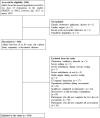Profile of adults users of smartphone applications for monitoring the level of physical activity and associated factors: A cross-sectional study
- PMID: 36203689
- PMCID: PMC9530973
- DOI: 10.3389/fpubh.2022.966470
Profile of adults users of smartphone applications for monitoring the level of physical activity and associated factors: A cross-sectional study
Abstract
Background: There are currently more than 200 million smartphones in Brazil. The potential of mobile technologies for favorable changes in health behavior such as physical activity has been previously described in the literature. Results of surveys in developed countries indicate that applications (APPs) are developed for people who are better educated, younger, and with higher incomes compared to non-users. However, the profile of users in developing countries like Brazil is not well-known. Understanding the profile of APP users might ease the development turned to physically inactive people and those at higher cardiovascular risk. Furthermore, the physiological and functional factors associated with the use of such APP are unknown.
Objectives: To characterize the profile of APP users to monitor the physical activity level (PAL) and assess the demographic, socioeconomic, clinical, physiological, and functional characteristics associated with the use of smartphone APPs to monitor physical activity in Brazilian adults.
Methods: We assessed 176 asymptomatic men and 178 women (43 ± 12 years; 27 ± 5 kg/m2). We initially asked participants about their current use of a smartphone APP containing PAL monitoring functionality, such as exercise session logs and/or step counts. In a cross-sectional design, we investigated schooling, socioeconomic status (Critério Brasil), and classic self-reported cardiovascular risk factors. We evaluated several physiological and functional variables such as maximum O2 consumption on a treadmill (VO2 max), blood pressure, body composition (bioelectrical impedance), handgrip strength, and isokinetic muscle strength of the dominant lower limb. Participants used a triaxial accelerometer for 7 days to quantify daily physical activity. We also assessed health-related quality of life (WHOQOL BREF), perceived stress (PSS14 Scale), and the built environment (NEWS Scale). We compared continuous variables using the Student's t-test and categorical variables using the χ2 test, between APP users and non-users. After univariate analysis, we included the main variables associated with the use of APP in a multiple logistic regression model.
Results: One hundred and two participants (28.3%), unrelated to gender, reported using a smartphone APP for physical activity at the time of assessment. Except for perceived stress and the built environment that were not associated with the use of APP, users of APP were younger and had higher education, lower cardiovascular risk, better socioeconomic status, a better quality of life, better cardiorespiratory function, better body composition, greater physical fitness and more moderate to vigorous physical activity in daily life. The results of the multiple logistic regression showed that age, hypertension, VO2 max, socioeconomic status (Critério Brasil), and quality of life (WHOQOL BREF total score) were the variables most significantly associated with the use of the APP.
Conclusions: Our results indicate that smartphone APPs to monitor physical activity are developed for younger adults with better socioeconomic status, lower cardiovascular risk, higher quality of life, and greater cardiorespiratory fitness. Greater efforts are needed to develop a science-based APP for people who most need this technology, enabling greater potential to prevent undesirable health outcomes in asymptomatic adults.
Keywords: Brazil; demographics; mobile Health (mHealth); physical fitness; risk factors.
Copyright © 2022 Vieira, Ostolin, Simões, Proença and Dourado.
Conflict of interest statement
The authors declare that the research was conducted in the absence of any commercial or financial relationships that could be construed as a potential conflict of interest.
Figures
References
Publication types
MeSH terms
LinkOut - more resources
Full Text Sources


